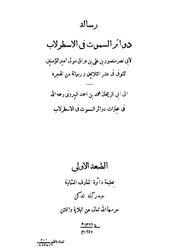File:دوائر السموت في الاسطرلاب (1947) - منصور بن عراق.pdf

Original file (1,239 × 1,733 pixels, file size: 242 KB, MIME type: application/pdf, 27 pages)
Captions
Captions
Summary
[edit]| Abu Nasr Mansur: العربية: دوائر السموت في الاسطرلاب
|
|||||||||||||||||||||
|---|---|---|---|---|---|---|---|---|---|---|---|---|---|---|---|---|---|---|---|---|---|
| Author |
author QS:P50,Q2383120 |
||||||||||||||||||||
| Title |
العربية: دوائر السموت في الاسطرلاب |
||||||||||||||||||||
| Printer |
مطبعة دائرة المعارف العثمانية |
||||||||||||||||||||
| Description |
العربية: دوائر السموت في الاسطرلاب (1947) - منصور بن عراق |
||||||||||||||||||||
| Language | Arabic | ||||||||||||||||||||
| Publication date |
1947 publication_date QS:P577,+1947-00-00T00:00:00Z/9 |
||||||||||||||||||||
| Place of publication | حيدرآباد | ||||||||||||||||||||
| Source | Internet Archive identifier: almoataz2006_yahoo_20180815 | ||||||||||||||||||||
This file is in PDF format.
Portable Document Format (PDF) is a file format created by Adobe Systems for document exchange. PDF is used for representing two-dimensional documents in a manner independent of the application software, hardware, and operating system. Each PDF file encapsulates a complete description of a fixed-layout 2D document that includes the text, fonts, images, and 2D vector graphics which compose the documents. The best way to view PDF files is locally using a reader.Several free readers for every system are available at pdfreaders.org. العربية | Deutsch | English | español | français | македонски | Nederlands | português | русский | +/−
|
Licensing
[edit]This image is in the public domain because it is a mere mechanical scan or photocopy of a public domain original, or – from the available evidence – is so similar to such a scan or photocopy that no copyright protection can be expected to arise. The original itself is in the public domain for the following reason:
This tag is designed for use where there may be a need to assert that any enhancements (eg brightness, contrast, colour-matching, sharpening) are in themselves insufficiently creative to generate a new copyright. It can be used where it is unknown whether any enhancements have been made, as well as when the enhancements are clear but insufficient. For known raw unenhanced scans you can use an appropriate {{PD-old}} tag instead. For usage, see Commons:When to use the PD-scan tag. | |||||
| Public domainPublic domainfalsefalse |
This work is in the public domain in India because its term of copyright has expired.
The Indian Copyright Act applies in India to works first published in India. According to the Indian Copyright Act, 1957, as amended up to Act No. 27 of 2012 (Chapter V, Section 25):
Note that this work might not be in the public domain in countries that do not apply the rule of the shorter term and have copyright terms longer than life of the author plus 60 years. In particular, Mexico is 100 years, Jamaica is 95 years, Colombia is 80 years, Guatemala and Samoa are 75 years, and Switzerland and the United States are 70 years.
العربيَّة | বাংলা | Deutsch | English | français | हिन्दी | italiano | 日本語 | ಕನ್ನಡ | македонски | മലയാളം | मराठी | Nederlands | português do Brasil | sicilianu | தமிழ் | ತುಳು | اردو | 繁體中文 | +/− |
 |
File history
Click on a date/time to view the file as it appeared at that time.
| Date/Time | Thumbnail | Dimensions | User | Comment | |
|---|---|---|---|---|---|
| current | 10:21, 12 March 2022 |  | 1,239 × 1,733, 27 pages (242 KB) | Nehaoua (talk | contribs) | الكتاب ضمن السلسلة |
| 10:20, 12 March 2022 |  | 939 × 1,454, 177 pages (4.83 MB) | Nehaoua (talk | contribs) | Importation from Internet Archive via IA-upload |
You cannot overwrite this file.
File usage on Commons
The following page uses this file:
Metadata
This file contains additional information such as Exif metadata which may have been added by the digital camera, scanner, or software program used to create or digitize it. If the file has been modified from its original state, some details such as the timestamp may not fully reflect those of the original file. The timestamp is only as accurate as the clock in the camera, and it may be completely wrong.
| Short title |
|
|---|---|
| Author | أبو نصر منصور بن علي بن عراق |
| Copyright status | Copyright status not set |
| Keywords | مطبعة دائرة المعارف العثمانية بحيدرآباد الدكن 1366 |
| File change date and time | 15:23, 7 April 2010 |
| Date and time of digitizing | 15:23, 7 April 2010 |
| Date metadata was last modified | 15:23, 7 April 2010 |
| Encrypted | no |
| Page size |
|
| Version of PDF format | 1.6 |



